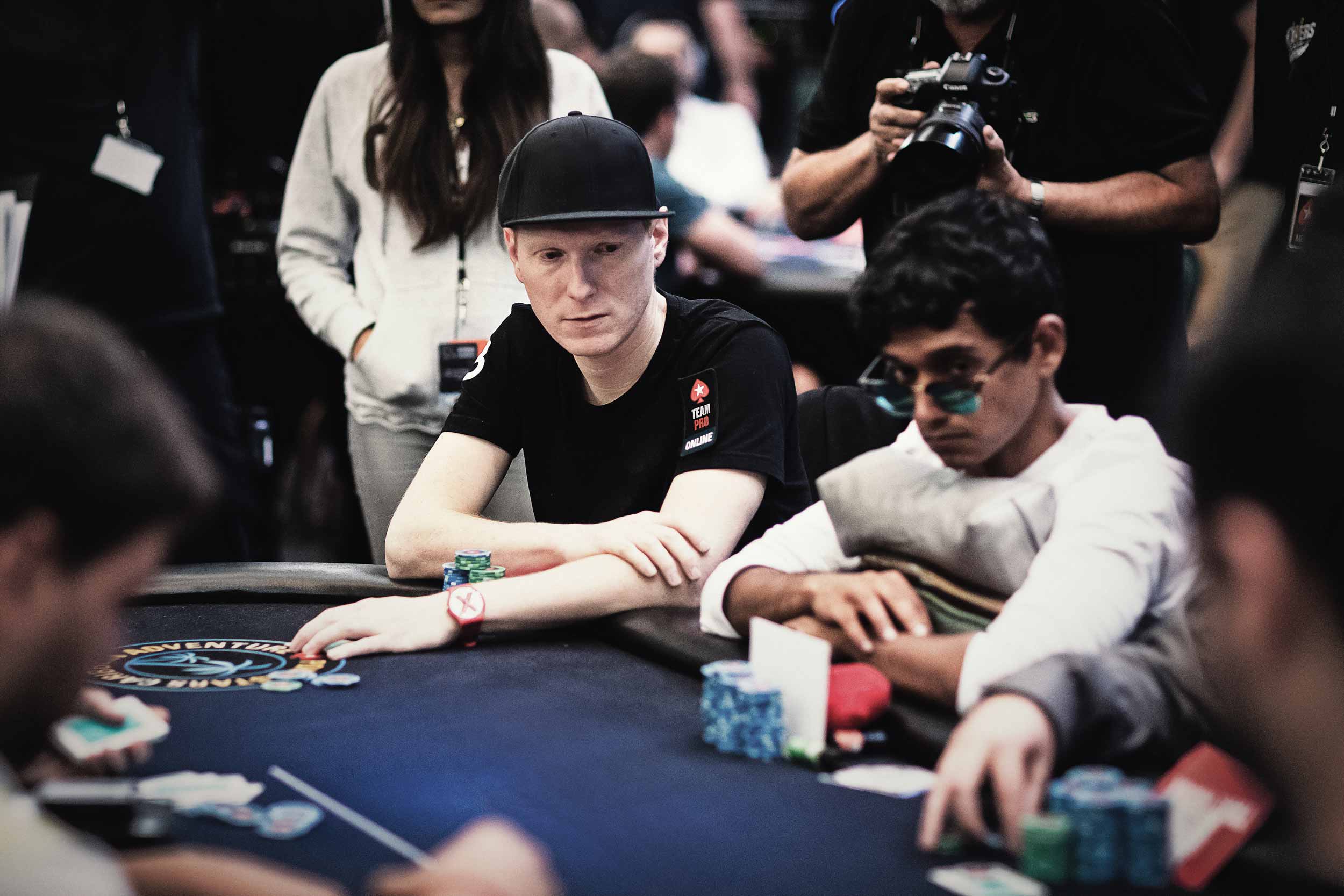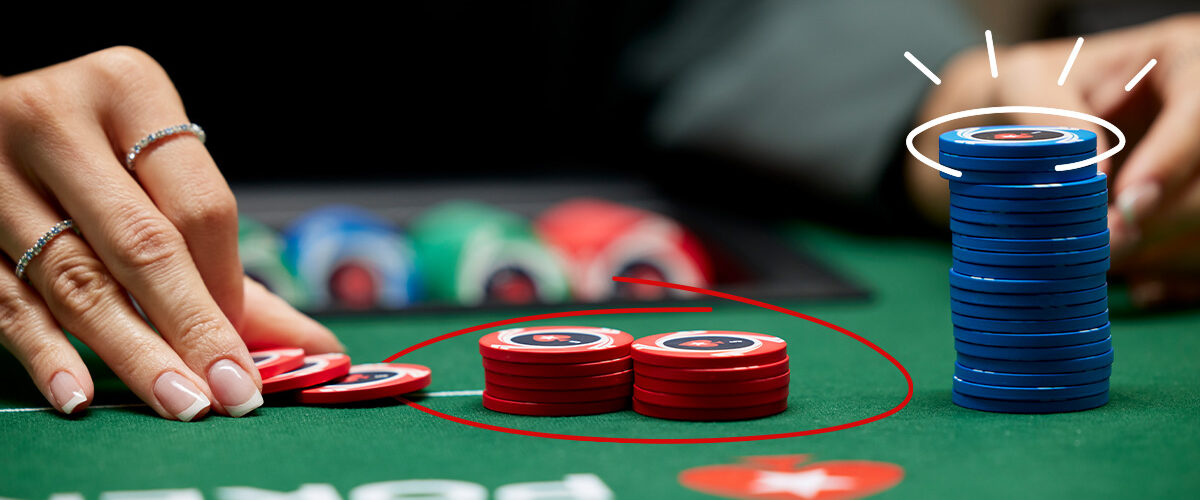The Middle Stage
The middle stage is characterised by the decreasing relation of the stack size to the blinds and the ante, and the late stage you have to be ready to live or die by the hole cards in front of you. In contrast to the early stage, the game in the middle and late phases have much less in common with the classic cash game. The average stack is often only around 30 BBs. Decisive here is playing the right game for the various stack sizes.
Starting hand selection
Starting hand selection in the middle phase is quite different from that of the early phase. Because the average stack is now only around 30 BBs, the implied odds are no longer adequate for many speculative hands – such as small pairs (22-66) and suited connectors – to call.
There are other ways of playing these hands. One way would be to 3-bet both types of hand instead of just calling. The advantages of this are that the aggression could push weak or even fairly good hands out of the pot before the flop, and again after the flop with a c-bet representing a strong hand. The disadvantage is that we will risk a lot of chips at a crucial stage with a weak hand.
An alternative way of playing speculative hands would be to call in position and, should we not hit, fashion a bluff attempt if our opponent looks to have missed also, as it should have a good chance of succeeding against certain players.
However, there is strong argument for simply folding speculative hands and concentrating on those hands that increase in value in the middle phase: middle to high pairs and aces with high kickers. These hands are strong enough for a preflop all-in, and they can also be played well post-flop if we didn’t go all-in beforehand.


Why should you steal the blinds?
As the size of the blinds increases, stealing them automatically becomes more interesting. The extra fee paid per hand substantially increases the number of chips we need per orbit.
Example 1: Blinds: 100/200, no ante. Every player has to pay 300 chips in blinds per orbit.
Example 2: Nine players, blinds: 100/200, ante: 25. Every player has to pay 525 chips in blinds and ante per orbit.
This amount we pay per orbit is identical to the number of chips already in the pot before the action has even started. By comparison with the previous example without an ante, this is an increase of around 70%! Stealing the blinds is thus much more lucrative.
We must now adjust our strategy so that we attack the blinds more aggressively than the other players. In order to keep our stack constant, we have to win the blinds and the ante only once per orbit on average. And if we manage to do it twice, we’ll be up one orbit!
Tips for stealing the blinds
The classic blind steal is a raise from the late position, best of all from the button. The position is important for two reasons: firstly, because we have position on both blinds and secondly, because there are fewer players after us who could be holding a premium hand.
If we attack the blinds with a weak hand from a middle position, we are disadvantaged for two reasons: we’re out of position to any callers, and other players could also 3-bet and force us to fold.
The small blind is also suitable for stealing the blinds, but we would have the decisive disadvantage of not having position post-flop. Stealing from the small blind requires caution, and it may be wise to continue folding weak hands, limp marginal hands and raising strong hands – or potentially just call if the player to our left is an aggressive player.
What is important for us in the small blind is that we raise more than normal, which again is dependent on position, and that we’re only playing against the big blind. With a normal raise, the big blind would have such good pot odds (considering the added antes) that they could call with a large variety of hands. For this reason, we should bend our established bet-sizing rules and raise to at least 4 BBs.
The strength of our own hand is important for a blind steal but not decisive. We can attack the blinds with a wide variety of hands, especially in late position. These include all Broadway combinations, pairs, suited connectors (also with a gap) and good suited king-queen combinations.
Decisive for a blind steal is that no other player is in the hand ahead of us. When another player has already called, we need a considerably stronger starting hand if all players ahead of us have folded. This is because an open raise often wins the hand before the flop, so the strength of our own hand itself is irrelevant. However, if another player has already called, that player will generally also call a raise, and then we’re going to have to hit a strong hand on the flop. The quality of our own hand in this case is therefore more important.
Another important aspect is the size of the blinds’ stacks, the big blind in particular. If one or both blinds have very small stacks, there is an increasing probability that they will very often go all-in. Big stacks defend their blinds more often because they don’t like being “pushed around”. Difficult situations can arise in both cases if we try to steal the blinds with very weak hands. Ideally, both the small blind and big blind have medium-sized stacks and are known for often surrendering their blinds.


Why raises are smaller from the middle phase onwards
In the middle phase of a tournament, players change from a normal raise size of 3 BBs plus 1 BB per limper to the slightly smaller raise size of around 2.5 BBs. At first sight this may appear pointless or at least irrelevant, because the pot is larger thanks to the addition of the ante. The idea behind this was that it would lead to bigger raises. In practice, however, exactly the opposite occurs.
Because of the high blinds and the ante, the players have stacks that, measured in BBs, are relatively small, as rule between 5 and 30 BBs. If we now raise a hand like 77 in a middle position and with a stack of 25 BBs, it makes (almost) no difference to the players after us whether we’ve raised 2.5 or 3 BBs. But if a player re-raises us, we will often be forced to fold. A raise of only 2.5 BBs would save us 0.5 BBs! The smaller our stack, the greater the effect of this 0.5 BB.
Here’s another advantage: in that we now risk fewer chips – the raise doesn’t have to be successful as often in order to be profitable.
Example
- Nine players, blinds: 500/1000, ante: 100
- We’re holding 77 in the middle position.
- Four folds, Hero raises to 2,500, everybody folds
In this example, we win 2400 chips from the pot. Because we bet only 2,500 chips, our raise has to win the pot straight away only once in every two attempts in order to be profitable in the long term.
In cases in which we don’t win the pot before the flop, we win additional chips after the flop if our hand improves and becomes the strongest one.
Another advantage of this minimal reduction in the raise is that, if we are called, the pot is correspondingly smaller. We thus have less difficulty folding weak post-flop hands if our opponent shows strength.
It is a disadvantage that players who enter the pot after us get good pot odds. This applies particularly to the big blind. In the example above, the big blind only has to put 1,500 into a pot of 4,900, giving them worthwhile pot odds of 3.3:1.
Defending the blinds
In the above sections we have seen that we get very good pot odds, especially as the big blind, thanks to the ante and the smaller raises. In general, we shouldn’t defend our big blind against raises in earlier positions when we’re holding marginal hands.
Faced with raises from middle and late positions, we should 3-bet when holding strong to very strong hands. Especially against players who often attack the blinds from late positions, we should also defend our blind with marginal hands such as 55 or Q♥ 10♥ . When we do so, the important thing is to select cards that give us a chance of hitting a good flop. Hands that are easily dominated, such as low ace and king combinations, should be folded. This will enable us to avoid problems if we hit top pair without a kicker.
If we only called in the big blind we should very often check the flop to the preflop aggressor and then raise, call or fold, depending on our hand and the flop structure. An exception may arise when the flop is good for us but very draw-heavy. In this case it makes sense to bet ourselves and thus deny the preflop aggressor a free card.
Test your knowledge with our short quiz below


